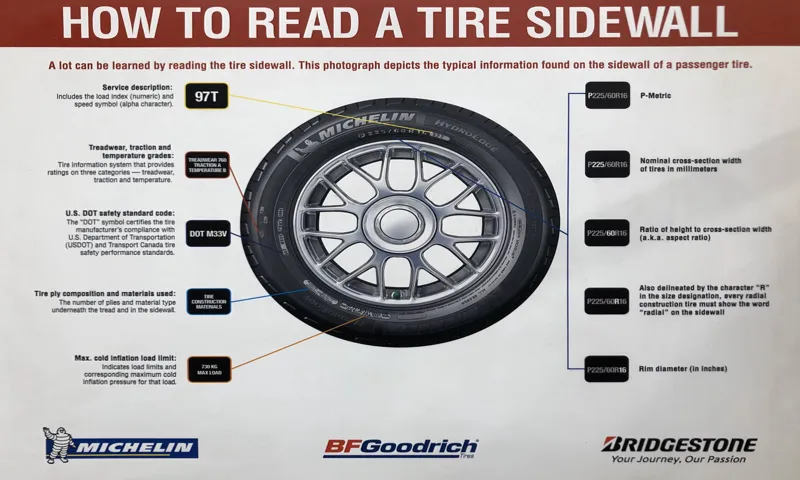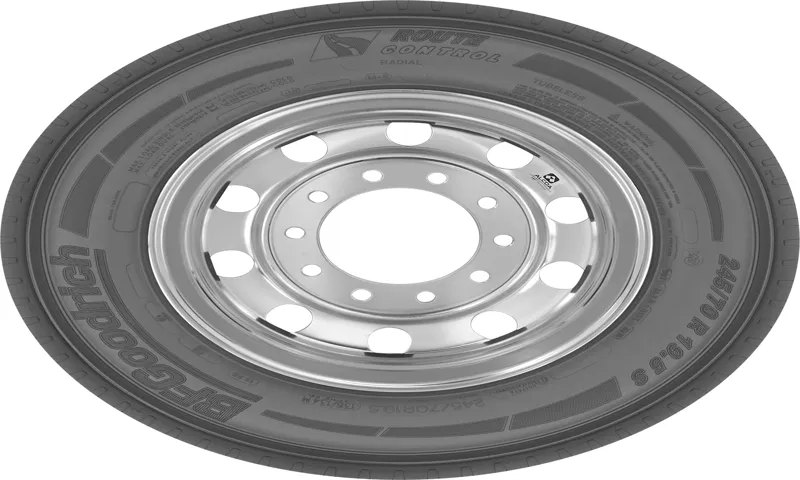Have you ever stopped to take a closer look at the sidewalls of your tires? Most of us don’t pay much attention to this crucial component of our vehicle’s tires, but understanding their importance can actually save you a lot of trouble down the road (no pun intended). The tire sidewall is the part of the tire that connects the tread to the wheel and offers crucial information about the tire’s size, load capacity, and speed rating. Think of it as the tire’s “business card,” providing essential data to mechanics, manufacturers, and even law enforcement officers in case of an accident.
In this blog post, we’ll explore the ins and outs of tire sidewalls, including what they’re made of, how they’re structured, and how to interpret the various numbers and letters stamped on them. By the end of this article, you’ll have a newfound appreciation for the critical role tire sidewalls play in keeping you safe on the road. Let’s dive in!
Table of Contents
What is a Tire Sidewall?
If you’ve ever looked closely at a tire, you may have noticed the raised lettering on the side. That is the tire sidewall, and it serves a crucial function in ensuring the overall safety and performance of the tire. Essentially, the sidewall connects the tire tread to the wheel, providing support for the weight of the vehicle and helping to absorb shock and impact while driving.
In addition to its functional role, the sidewall also contains important information about the tire, such as its size, load rating, and speed rating. This information is essential for ensuring that the tire is compatible with your vehicle and that it is being used properly. Overall, while the sidewall may seem like a small and insignificant part of a tire, it is actually a key component that plays an important role in keeping you safe on the road.
So, next time you’re checking your tire pressure, take a moment to appreciate the humble sidewall and its vital role in your vehicle’s performance.

Parts of a Sidewall
If you have ever taken a closer look at your car tire, you may have noticed some information printed on the sidewall. The tire sidewall is the portion of the tire located between the tread and the bead. It plays a crucial role in supporting the weight of the vehicle and providing stability while driving.
A tire sidewall has several parts, including the tire size, load index, speed rating, and tire type. The tire size indicates the diameter, width, and aspect ratio of the tire, which assists in acquiring the correct tire for the vehicle. The load index offers information on the maximum weight capacity the tire can handle, while the speed rating indicates the maximum speed limit the tire can withstand.
Lastly, the tire type denotes whether the tire is suitable for regular use or for driving in adverse weather conditions such as snow or mud. Understanding the information on the sidewall of your tire is essential for ensuring you have the right tire for your vehicle, enabling you to remain safe and get the best performance on the road.
Ply Rating and Composition
When it comes to tires, the sidewalls are an often-overlooked but important component. They provide support for the tread and protect the tire from punctures and impacts. The sidewall consists of several parts, including the ply rating and composition.
The ply rating refers to the number of layers or plies that make up the sidewall. A tire with a higher ply rating will generally be stronger and more durable than one with a lower ply rating. The composition of the sidewall can also vary, with some tires featuring materials like steel or Kevlar for added strength and puncture resistance.
It’s important to consider both the ply rating and composition when selecting a tire, as they can impact the tire’s performance, longevity, and overall safety on the road.
Aspect Ratio and Load Index
When it comes to understanding the parts of a sidewall, two essential components are the aspect ratio and load index. The aspect ratio is the measurement of the tire’s height in comparison to its width. This ratio is indicated by a two-digit number after the tire size, and it represents the tire’s sidewall height as a percentage of its width.
A higher aspect ratio indicates a taller sidewall, which can lead to a more comfortable and smoother ride. On the other hand, a lower aspect ratio means a shorter sidewall, which allows for better handling and cornering abilities. The load index, on the other hand, indicates how much weight a tire can support.
This index is represented by a two or three-digit number following the aspect ratio. Higher numbers mean that the tire can support more weight, which is crucial for larger vehicles that carry heavy loads. Understanding the load index is crucial for ensuring safety on the road, as exceeding a tire’s load capacity can lead to tire failure and accidents.
In short, the aspect ratio and load index are crucial parts of a tire’s sidewall that should not be overlooked when purchasing new tires. Whether you value a comfortable ride or need to carry heavy loads, understanding these components will help you find the right tire for your needs, ensuring both safety and performance on the road.
Importance of Sidewalls
What is a tire sidewall? Well, it may seem like just a small part of the tire, but the sidewall plays a crucial role in the overall performance and safety of your vehicle. The sidewall is the vertical area between the tread and the bead of the tire. It contains important information such as the tire size, load capacity, and speed rating.
The design of the sidewall also impacts the handling and ride comfort of the vehicle. A weak or damaged sidewall can lead to a blowout, which can be extremely dangerous, especially at high speeds. It’s important to regularly inspect your sidewalls for cracks, bulges, or other signs of damage.
Choosing the right tire with a strong and durable sidewall can improve your car’s handling, increase fuel efficiency, and keep you safe on the road. So, don’t underestimate the importance of the little sidewall – it’s a critical component of your tire!
Tire Durability and Stability
When it comes to tire durability and stability, one crucial factor that often gets overlooked is the importance of sidewalls. Sidewalls are the sections of the tire that connect the tread to the rim, and they play a significant role in maintaining the overall structure and handling of the tire. The sidewalls provide support and shock absorption, allowing the tire to maintain its shape and stability even when facing sudden impacts and rough terrain.
A well-constructed sidewall can prevent tire damage, improve handling, and extend the overall life of the tire. On the other hand, a weak or damaged sidewall can lead to blowouts, punctures, and other hazards on the road. When choosing a tire, it’s essential to prioritize sidewall strength and durability to ensure a safe and smooth ride.
Tire Performance and Safety
When it comes to tire performance and safety, sidewalls play a crucial role. They are the vertical portion of the tire that connects the tread to the bead and are responsible for absorbing shock as the vehicle moves over uneven surfaces. Sidewalls can also provide important information about the tire, such as size, load capacity, speed rating, and other specifications.
In addition to their functional importance, sidewalls also impact the aesthetic of the tire. Many manufacturers offer sidewall designs that allow drivers to customize the look of their vehicle. However, it’s important to remember that sidewall damage or wear can seriously impact tire performance and safety.
Even small cuts or cracks can lead to blowouts or tire failure. Regular inspections can help identify issues early on and prevent potential hazards. So, pay attention to your tire sidewalls, they may not be the most glamorous part of your tires, but they are certainly an integral part of keeping you safe on the road.
Sidewall Maintenance Tips
If you are a vehicle owner, you must have heard about the tire’s sidewall, which forms the outermost part of the tire. Generally, it is where the manufacturer imprints vital details such as the tire’s size, brand, and maximum inflation pressure. While you may not put much thought into it, the tire’s sidewall plays an essential role in the tire’s performance and safety.
Therefore, it is vital to maintain it properly to avoid mishaps on the road. Some simple tips to maintain the tire sidewall include regular cleaning, avoiding over-inflation, and avoiding contact with unwanted substances like oil and grease. These simple steps can go along way to prolong the life span of your tires and keep you safe while on the road.
Inspect Regularly
Regularly inspecting the sidewalls of your tires can save you from a lot of trouble down the road. By regularly checking for any signs of wear, tear, or damage, you can prevent accidents and ensure that your tires last longer. It’s important to note that sidewall damage is not always visible from the surface, and that’s why you need to make it a habit to inspect them closely.
Look out for deep cuts or punctures that have penetrated the rubber, bulges or blisters, cracks, or any signs of uneven wear. If you notice any of these, it’s time to replace your tires as soon as possible. Remember, your safety on the road depends on the condition and maintenance of your tires, so don’t take this task lightly.
By inspecting your tires regularly, you can stay ahead of any potential issues and ensure that you and your loved ones stay safe on the road.
Proper Cleaning
When it comes to maintaining the lifespan of your tires, proper cleaning is key. This includes the sidewalls of your tires, which can often be neglected. However, neglecting the sidewalls can have serious consequences, such as cracking, dry rot, and discoloration.
To protect your tires, it is crucial to clean the sidewalls regularly. It’s quite easy to clean sidewalls; all you need is a gentle cleanser and a soft-bristle brush. Apply the cleanser to the brush and gently rub it onto the sidewall, taking care not to scrub too hard.
Rinse with water and dry with a clean towel or cloth. Remember, a little care can go a long way in ensuring the longevity and durability of your tires, including their sidewalls. So, take the time to clean them regularly, and you’ll reap the rewards for years to come.
Check Inflation Pressure
Maintaining the inflation pressure in your tires is crucial for extending their lifespan and ensuring your safety while driving. In fact, it’s recommended that you check your tire pressure at least once a month or before any long road trip. To do this, you can use a tire pressure gauge, which is a simple device that measures the air pressure inside your tire.
The recommended pressure is usually indicated on the sidewall of your tire, so make sure to check your tire manufacturer’s guidelines before inflating your tires. Over or under-inflation can result in a host of problems, including poor handling, uneven tire wear, reduced fuel efficiency, and even tire blowouts. Therefore, make sure to keep your tires inflated to the recommended pressure for optimal performance and safety on the road.
Conclusion
In summary, a tire’s sidewall is like the unsung hero of the wheel world – it’s often overlooked, but it plays a crucial role in keeping us rolling. Not only does it hold important information about the tire’s size and specs, but it also provides vital protection against damage and helps maintain proper handling and stability. So next time you’re cruising down the road, give a nod of thanks to your trusty tire sidewalls – they may not be flashy, but they’re definitely essential.
“
FAQs
What is a tire sidewall?
The sidewall of a tire is the part of the tire that connects the top and bottom portions (tread and bead). It is the part of the tire that displays important information like the tire size, type, load index, and speed rating.
Why is the tire sidewall important?
The sidewall plays a crucial role in supporting the weight of a vehicle and absorbing shock from the road. It also protects the tire from damage and helps communicate important information about the tire.
What are the components of a tire sidewall?
The rubber sidewall of a tire is made up of several layers, including the inner liner, body ply, and bead core. These layers work together to provide strength and flexibility to the tire.
How should I check my tire sidewall for damage?
Check your tire sidewall regularly for cuts, bulges, and other signs of damage. If you notice any issues, have your tires inspected or replaced by a professional.
Can the tire sidewall be repaired?
It is generally not recommended to repair a damaged sidewall, as it can compromise the structural integrity of the tire. It is safer to replace the tire entirely.
How can I choose the right tire sidewall for my vehicle?
When selecting a tire, consider your vehicle’s make and model, driving habits, and the type of weather and terrain you will be driving on. Consult with a professional or refer to your vehicle’s owner’s manual for recommendations.
What is the difference between a white letter tire sidewall and a black letter tire sidewall?
A white letter tire sidewall is a tire with raised white lettering on the sidewall, while a black letter tire sidewall has black lettering on a black background. The choice between the two is purely cosmetic.




